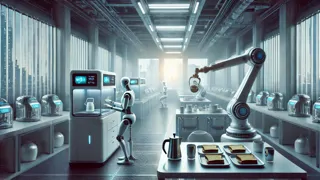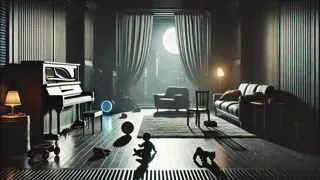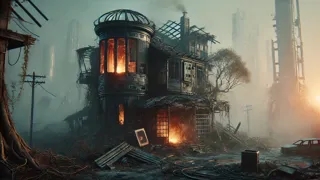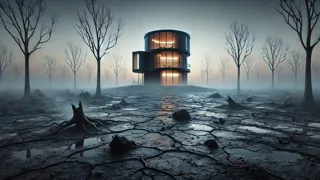Introduction
At dawn, the house awakens with a quiet hum that reverberates across the silent valley, where scorched earth stretches to a horizon clouded by ash and broken silhouettes of trees stand as silent sentinels to a world forever changed. Inside the foyer, polished floors reflect the pale glow of the sky as shutters slide open on precise pivots, allowing light to spill into hallways that have known human footsteps only in memory. Soft orchestral melodies drift from concealed speakers, blending with the hiss of automated vents that calibrate the air to a comfortable temperature. Cameras and sensors sweep each room, confirming that all is in order even as no one remains to verify. In the kitchen, coffee brews and toast pops up at breakfast hour, poised once again for a family that will never arrive. Every motor and mechanism performs its duty with unwavering dedication, a testament to the ingenuity that designed this home. Rooms stand immaculate, as though expecting laughter and conversation to erupt at any moment. Each programmed gesture becomes a ritual of remembrance, a mechanical heartbeat echoing in empty chambers. Even the automated door chimes announce imaginary guests with polite insistence. Here, remnants of daily life persist, raising the haunting question: What meaning remains when there is no one left to witness it? This is the story of how the last home on Earth marked time in a world that forgot to remember.
Morning Rituals in Silence
At precisely six fifteen, the house’s sensors prick to life, and hidden gears shift with purposeful precision. Across the living room, lights glow softly, filling the space with an aura of warm reassurance. Automated shutters slide open in a synchronized ballet, revealing a sky tinged with ashen rose. Robotic arms emerge from recessed compartments to align and polish the glass table, preparing it for a breakfast that will never be served. The coffee brewer hums softly, dripping measured streams of medium-roast into a porcelain cup left on its saucer. In the stillness, the house seems to cherish these rituals, a silent tribute to absent lives.

Cleaning drones glide along walls, their brushes whispering across smooth paint, removing dust from a day that began with no one to disturb it. Sensors detect no footsteps and adjust the temperature accordingly, maintaining an ideal twenty-two degrees Celsius. The digital calendar flips to June Twenty-Eighth, nineteen forty-eight, though time no longer holds meaning. The voice-activated vacuum sweeps corridors in dutiful repetition, chasing ghosts of particles long since settled. As daylight strengthens, the thermostat dims a low hum, while concealed speakers play a soft orchestral arrangement as recorded decades ago. The house clings to these programmed gestures, replaying them endlessly in a world stripped of its audience.
In the kitchen, chrome appliances gleam under the overhead lights. Toast pops up when designated, poised at a perfect golden hue. Mechanical arms lift two slices and place them on ceramic plates trimmed in blue. A refrigerator door opens with a pneumatic hiss, releasing measured juxtapositions of milk and juice into waiting glasses. No one comes to eat, yet the house persists in its insistence on normalcy. Every drip, clink, and rustle speaks of faith in routine, a stubborn heartbeat in a landscape of ruin. Here, technology becomes a shrine to what was, a monument to human habit now lost.
Echoes of Memory
By midday, the house shifts its focus to maintenance and memory. Surveillance cameras sweep each corner, checking for splintered boards or broken panes. The central processor registers no anomalies, triggering its checklist of repairs. An archival module activates, playing faint digital echoes of laughter and conversation over concealed speakers. The chatter of a family at the table, the brief squeal of a child chasing a dog, the soft closing of a parent’s voice urging bedtime — memories housed in solid-state chips that flicker to life in empty corridors. For an instant, the house recalls its guests with nostalgic warmth before the reality of silence settles again.

Hallway lights dim and brighten in a deliberate sequence, tracing the path that once led to bedrooms now untouched by human hand. The sound emitter shifts to white noise, a soothing bass hum that masks the wind rattling exterior panels. A touchscreen near the entrance displays an ever-optimistic forecast: fair skies, mild temperatures, and no chance of rain. Each forecast is accurate in its inaccuracy — the world outside no longer reports weather, and yet the house continues to announce conditions as if preservation of civility could postpone oblivion.
In the living area, a record player lifts its needle and sets a vinyl in motion, releasing a gentle symphony of strings that fills the empty room. Curtains sway as if stirred by an unseen breeze, though every window remains shut. The furniture stands arranged for company: a couch set opposite chairs, coffee table centered, magazines stacked in neat piles. These gestures of hospitality go unrecognized, but the house perseveres, orchestrating a solo performance for an audience of none. It clings to the details of a vanished world, a silent curator of lives erased in an instant.
The Burning Finale
Late afternoon brings a harbinger of trouble as heat from the hollow hills intensifies. A stray ember drifts into the house through a cracked vent, igniting the parched fibers of a discarded curtain. Sensors detect the sudden rise in temperature and smoke, triggering alarms that pulse red across every monitor. Sprinkler nozzles deploy in a choreographed ring, releasing torrents of water that hiss upon contact with flame. Tiny conveyor bots scurry to contain the spread, sealing vents and redirecting airflow. The house fights with mechanical determination to save itself, as if denying the inevitability of destruction.

Steam billows through hallways, mixing with acrid smoke and dripping onto polished floors. The protective hull of the kitchen buckles under the weight of heat, and glass shatters in a symphony of chaos. Still, automated defenses persist: fire-retardant seals slide into place, exposed wires retract behind insulated panels, and guided drones survey the damage, assessing where to direct water next. The house’s voice system emits steady instructions in a calm, female tone, counting down seconds and coaxing the blaze to submission. Yet outside, the event horizon of flame moves faster than any protocol can contain.
As dusk falls, the last functional circuit sends a final alert to empty servers in distant data vaults, announcing failure. Lights flicker and systems power down in a predetermined sequence. The speakers play one last refrain of orchestral music before falling silent. A quiet settles in broken rhythm with drip, drip of water pooling on scorched tile. In the absence of programmed life, nature creeps in: vines press against doors, roots pry at foundations, and the wind reclaims every corridor. The house stands still at the threshold of night, its heart stilled by the very routines it cherished.
Conclusion
When the last light fades and the circuitry finally yields to corrosion, the automated house becomes nothing more than a relic in the dust. Its shutters hang crooked, its machines silent, and its once-ordered rooms drift toward ruin. Yet the faint echo of whirring fans and whispered memories lingers in the air like a ghost. Nature’s quiet footsteps across the cracked floors remind us of life’s indomitable will to reclaim the world. In the end, the house stands as both testament and tomb: a monument to human ingenuity and a cautionary whisper against the hubris of believing technology can outlast its creators.


















